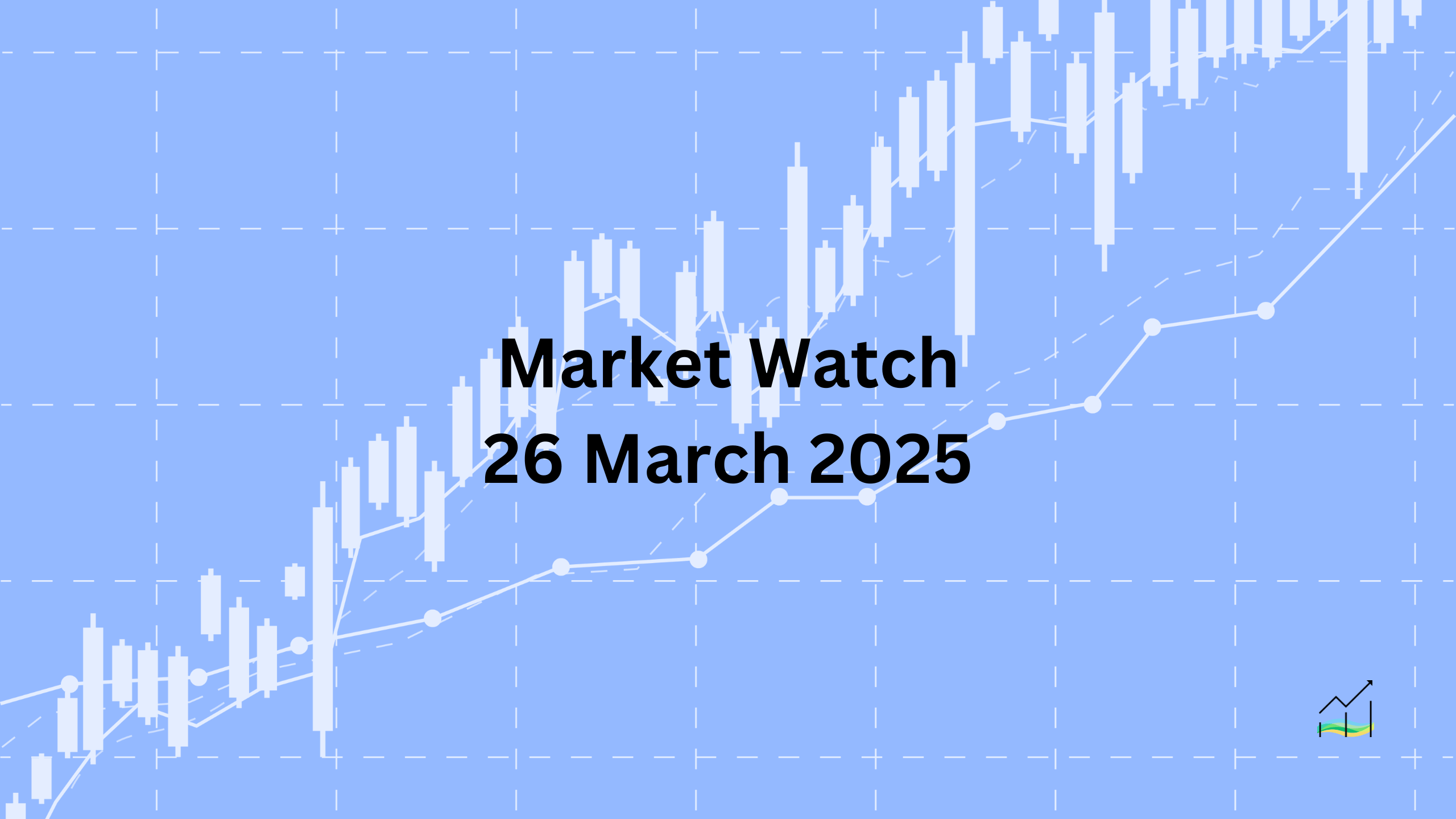26/03/2025 Market Watch

U.K. Inflation Surprise Keep Markets on Edge
Market sentiment remains cautious as uncertainty over next week’s potential US tariff announcement continues to weigh on global risk appetite. The US dollar is mostly stable against major currencies, while the British pound weakened following a soft inflation report and ahead of the UK’s Spring Budget Statement. In contrast, commodity-linked currencies are holding up better. Meanwhile, equity markets in Asia showed signs of recovery, although China and Taiwan lagged. European and US markets are under mild pressure, with bond yields mixed as investors assess inflation data and fiscal signals.
The US dollar is consolidating across G10 currencies, showing limited movement overall. The British pound declined by 0.3%, reflecting weaker-than-expected UK inflation data and anticipation surrounding the Spring Budget. In contrast, commodity-linked currencies such as those in the dollar bloc are outperforming. The Mexican peso is among the weakest emerging market currencies today, slipping by approximately 0.25%.
Asian equity markets mostly advanced, supported by gains in Japan and a firmer tone in Hong Kong. However, mainland China and Taiwan lagged behind. Overall, the MSCI Asia Pacific Index broke its three-day losing streak. In Europe, the Stoxx 600 is pulling back, giving up most of the previous day’s gains. US index futures are also trending lower.
Bond markets show mixed performance. European yields are slightly lower, with the UK’s 10-year Gilt yield dropping around three basis points to 4.73% on the back of soft inflation data. In the US, the 10-year Treasury yield is firmer near 4.33%, showing resilience despite a warning from Moody’s about the US fiscal outlook, which still carries a negative watch on its top-tier rating.
In commodities, gold is steady around the $2020 level, while May WTI crude oil remains firm, trading just below its recent high of $69.70, the strongest level since early March.
United States of America
Overview
The US Dollar Index is taking a breather after climbing for five consecutive sessions, showing signs of consolidation below recent highs. While markets have largely focused on soft economic indicators, signs of a real slowdown are emerging. The US economy, previously buoyed by post-2020 fiscal and monetary support, is now confronting policy-related risks, potential tax changes, and broader economic fatigue. Investor attention is shifting toward upcoming real-sector data, which may confirm the moderation in growth.
Economic Drivers
The broader economic picture is shifting as growth momentum cools. While some market participants mistakenly interpret this as stagnation, the slowdown aligns with the Federal Reserve’s projections for a return to trend growth. However, risks remain, particularly from government cutbacks and policy uncertainty.
- The US economy is transitioning from above-trend growth to a more sustainable, non-inflationary pace (~1.7%).
- Fiscal and monetary support helped sustain strong post-pandemic growth, but that tailwind is fading.
- Concerns are rising over further deceleration due to potential government layoffs, spending cuts, and immigration-related disruptions.
- Policy uncertainty around tariffs and taxes adds to downside risks for business confidence and consumer activity.
Data and Events
Markets are awaiting key upcoming data that could confirm a broader economic slowdown beyond survey-based indicators.
- February Durable Goods Orders (due today): Expected to decline after a sharp 3.2% rise in January.
- March Nonfarm Payrolls (due April 4): Forecasts point to a gain of around 120,000 jobs—potentially the weakest reading since October.
- Fed’s Summary of Economic Projections: The central bank forecasts GDP growth aligning with trend levels (~1.7%) this year.
Price Action
The US Dollar Index has paused its recent recovery, holding within a narrow range after a 1.25% rebound from last week’s low. It's consolidating beneath resistance near 104.45 and finding support around 104.20. After five straight daily gains, momentum may be slowing, and further direction likely depends on upcoming data and policy developments.
Key Points:
- The US Dollar Index is consolidating after a five-day rally.
- Economic slowdown is shifting from survey data to hard indicators.
- Durable goods and payrolls data are key upcoming signals.
- Fed expects growth to normalize, not stagnate.
- Fiscal tightening, tax/tariff uncertainty, and immigration issues pose downside risks.
Australia
Overview
The Australian dollar is showing strength, extending its recovery from last week’s losses as fiscal stimulus measures and softer inflation data shape market sentiment. While inflation continues to ease, the government’s surprise announcement of income tax cuts and expanded energy rebates marks a clear pre-election policy shift. Despite the looser fiscal stance, expectations for additional rate cuts by the central bank remain firmly in place.
Economic Drivers
Australia's macroeconomic landscape is shifting as inflation cools and the government embraces a more supportive fiscal stance ahead of upcoming elections. This policy pivot signals a willingness to tolerate higher deficits to support households.
- February CPI slowed to 2.4% from 2.5%, while the trimmed mean fell to 2.7% from 2.8%.
- Government announced income tax cuts, extended energy rebates, and raised the threshold for a healthcare tax.
- Budget deficit projected at A$42.1 billion through June 2026, revised from A$27.6 billion.
- Last year’s deficit stood at just under 2% of GDP.
- The shift toward fiscal expansion aims to support household consumption ahead of the May election.
Data and Events
Markets continue to monitor how recent developments will influence the central bank’s policy path.
- February CPI (Released): Eased to 2.4%, reinforcing disinflation trends.
- RBA Rate Cut Expectations: Futures imply two more cuts this year, with about a 50% chance of a third—unchanged from last week.
- May Federal Election: Fiscal measures introduced ahead of this key political event could influence economic momentum and consumer sentiment.
Price Action
The Australian dollar touched a three-day high near $0.6325, recovering about half of last week’s decline. It continues to probe resistance at that level during the European session. The next key retracement level sits at $0.6240 (61.8% mark). Momentum remains constructive, though price is nearing technical resistance.
Key Points:
- AUD rallied to a three-day high, retracing half of last week’s losses.
- February CPI and trimmed mean both declined, confirming cooling inflation.
- Government announced surprise fiscal stimulus measures ahead of May elections.
- Budget deficit widened, but RBA rate cut expectations remain unchanged.
- Futures still price in two cuts, with a 50% chance of a third.
Canada
Overview
The Canadian dollar continues to gain ground against the US dollar, marking its third straight session of strength and approaching monthly lows. While the economic calendar remains relatively quiet, attention is turning to Canada’s January GDP report due at the end of the week. Forecasts suggest economic momentum may be picking up, supported by optimistic projections from both the central bank and international observers. These developments are reinforcing the Canadian dollar’s recent outperformance.
Economic Drivers
Economic growth expectations in Canada are helping to support its currency. Although recent years saw modest expansion, current projections suggest an acceleration in activity for 2024.
- The Bank of Canada projects GDP growth of 1.8% for 2024, up from 1.5% in the previous two years.
- The IMF is slightly more optimistic, forecasting 2% growth.
- These expectations reflect improving economic conditions that could shape future monetary policy decisions.
Data and Events
With little on the calendar early in the week, focus is building around the upcoming GDP release.
- January GDP (Due Friday): Forecasted at 0.3% growth, which would be the strongest monthly gain since October.
- Options Expiry (Today): Approximately $635 million in options tied to CAD1.4240 are set to expire, which may influence short-term trading.
Price Action
The US dollar continues to weaken against the Canadian dollar, nearing the monthly low set on March 6 around CAD1.4240. A decisive break below this level could pave the way for a move toward CAD1.4200. The expiry of sizeable options at current levels may contribute to short-term volatility.
Key Points:
- Canadian dollar strengthens for a third consecutive session.
- USDCAD approaching key support near CAD1.4240.
- $635 million in options expiring today could affect price action.
- January GDP forecast at 0.3%, strongest since October.
- BoC and IMF project stronger growth for 2024, boosting sentiment.
China
Overview
The offshore yuan continues to weaken, extending its decline for a seventh straight session and reaching its lowest level since early March. Amid this downtrend, the People’s Bank of China (PBOC) has subtly adjusted its stance by setting a lower reference rate for the first time in five days. This move may signal a potential shift in China’s foreign exchange approach. Meanwhile, a major international port sale by a Chinese conglomerate is moving forward despite internal resistance, adding further interest to cross-border developments.
Economic Drivers
China’s foreign exchange management is under renewed scrutiny as the yuan depreciates and policymakers begin to tweak their approach. Market participants are watching closely for broader changes in currency policy.
- The offshore yuan has been on a seven-day losing streak.
- PBOC set a lower daily dollar fix for the first time in five sessions, signaling a possible shift in FX management.
- Weakening yuan may reflect both economic pressures and a cautious policy recalibration.
- Concerns around capital flows and global trade competitiveness may also be influencing the central bank’s stance.
Data and Events
While there are no immediate data releases, a major corporate development is drawing attention.
- CK Hutchison Port Deal (April 2): The $19 billion sale includes strategic assets on both sides of the Panama Canal. Despite some internal opposition, the deal is expected to proceed, highlighting ongoing capital reallocation by Chinese firms.
Price Action
The US dollar continues to appreciate against the offshore yuan, reaching CNH7.2750, its highest level since March 5. The prolonged rally suggests strong directional momentum. The shift in the PBOC’s reference rate fix may offer early clues to a potential policy response aimed at stabilizing the yuan.
Key Points:
- Offshore yuan weakens for the seventh straight session.
- PBOC lowers the dollar fix for the first time in five days, possibly signaling a shift.
- USD/CNH hits highest level since March 5.
- CK Hutchison’s $19B port sale proceeds despite pushback, deal expected to sign April 2.
- Markets are watching closely for further currency policy adjustments.
Europe
Overview
The euro remains under pressure after closing lower for five consecutive sessions. Although it briefly dipped below $1.0780 yesterday, it has since bounced slightly and is now trading in a tight range. With little on the eurozone’s economic calendar this week, price movement is being guided more by technical positioning and upcoming option expiries. The euro is currently fluctuating between its 20-day and 5-day moving averages, reflecting short-term indecision in the market.
Economic Drivers
There are currently no major economic drivers shifting sentiment in the eurozone. The lack of fresh data leaves the euro vulnerable to technical flows and broader dollar dynamics.
- No significant economic reports scheduled in the eurozone this week.
- Market focus remains on technical levels and positioning rather than macro developments.
- Broader global risk sentiment and dollar strength continue to indirectly influence the euro.
Data and Events
While the economic schedule is quiet, significant options expiries may shape short-term volatility.
- Options Expiry (Thursday): Nearly €2 billion in euro options set to expire.
- Options Expiry (Friday): Another €2.2 billion in options struck at $1.08 due to expire.
Price Action
The euro is trading just above $1.0780 in a tight range, caught between support at the 20-day moving average (around $1.0775) and resistance at the 5-day moving average (near $1.0810). Despite a slight bounce, five straight daily losses reflect continued bearish pressure. Large option expiries near $1.08 may keep price action contained.
Key Points:
- Euro rebounded slightly after dipping below $1.0780.
- Still closed lower for five sessions in a row.
- Trading between key short-term moving averages.
- No major eurozone data this week.
- Nearly €4.2 billion in options expiring at $1.08 may cap volatility.
Japan
Overview
The dollar’s recent rally against the yen has paused after reaching its highest level since early March. Despite strong US yields, sellers emerged near the JPY151 mark, pushing the pair lower. Now consolidating within a narrow range, the dollar's momentum faces a potential test near JPY149.50–60. Meanwhile, Japan's softening service inflation and reduced rate hike expectations are keeping the yen under pressure.
Economic Drivers
Weaker-than-expected inflation data and shifting rate expectations are shaping Japan’s monetary outlook, providing room for dollar strength—though technical levels remain key.
- Japan’s February services producer price index eased to 3.0% from a revised 3.2% in January.
- Inflation remains at the higher end of its recent range, but shows signs of slowing.
- Market expectations for Bank of Japan tightening have eased:
- Earlier this month: 50 bps in hikes expected for the remainder of the year.
- Now: About 38 bps priced in, equivalent to one full hike and a 50% chance of another.
Data and Events
There are no major new releases, but prior inflation data and shifts in rate pricing continue to influence sentiment.
- February Services PPI (Released): Slowed to 3.0%, below prior expectations.
- Rate Expectations (Ongoing): Markets now pricing in fewer BoJ hikes for 2025.
Price Action
The dollar surged to just below JPY151, its strongest level since March 3, before retreating as sellers stepped in. It slipped below JPY150 in North American trading and is now consolidating between JPY149.85 and JPY150.60. The dollar has gained 3% from the March 11 low (~JPY146.55). A decisive break below JPY149.50–60 would undermine bullish momentum.
Key Points:
- Dollar-yen hit highest level since March 3, near JPY151.
- Sellers emerged, pulling the pair back below JPY150.
- Japanese services inflation cooled to 3.0% in February.
- Market now pricing in only ~38 bps of BoJ hikes for 2025.
- Key support seen at JPY149.50–60; a break could challenge bullish momentum.
United Kingdom
Overview
Sterling reversed recent gains and retested Monday’s two-week low near $1.2885 following a weaker-than-expected inflation report. The currency had rebounded to $1.2960 but gave back those gains as soft CPI data reinforced expectations of policy caution. Market focus now turns to the Spring Budget Statement, where the UK government is expected to prioritize fiscal discipline. Meanwhile, a striking long-term decline in childhood growth rates has reignited broader concerns over living standards and public investment.
Economic Drivers
The UK’s inflation trends continue to moderate, aligning with the government’s preference for tighter fiscal management over increased spending or tax hikes. However, falling living standards are becoming harder to ignore.
- February CPI rose 0.4% month-over-month, with annual inflation slowing to 2.8% (from 3.0%).
- Core inflation eased to 3.5%, down from 3.7%.
- Services inflation held steady at 5.0%, indicating persistent pressure in domestic prices.
- The UK government is expected to pursue austerity rather than expand the budget deficit or raise taxes.
- Declining childhood height—a proxy for long-term living conditions—has raised alarms about the impact of reduced healthcare and nutrition standards.
Data and Events
Markets are closely watching both inflation outcomes and upcoming fiscal policy announcements for further guidance on UK economic direction.
- February CPI (Released): Headline inflation at 2.8% y/y; core at 3.5%.
- Spring Budget Statement (Today, ~8:30 AM EST): Chancellor Reeves expected to announce measures emphasizing spending restraint and long-term budget consolidation.
- Option Expiry (Today): GBP360 million in options at $1.2945 may influence intraday price movement.
Price Action
Sterling climbed from $1.2885 to $1.2960 but has since returned to the lower end of that range. Today’s high reached just under $1.2950, pressured by weaker CPI data. Heavy option interest around $1.2945 could anchor prices short term. The return to Monday’s low signals renewed bearish pressure unless supported by clearer fiscal or economic catalysts.
Key Points:
- Sterling reversed gains, dropping back toward a two-week low.
- February CPI came in softer than expected, easing pressure on the Bank of England.
- Core and headline inflation continued to decline; services inflation remained elevated.
- GBP360 million in options at $1.2945 expire today, influencing short-term movement.
- Spring Budget expected to favor austerity over deficit expansion or tax hikes.
- Long-term indicators suggest worsening UK living conditions, raising social and policy concerns.
© 2025 SKONE Enterprise (003319453-V). All rights reserved.
The content on this site is for informational purposes only and does not constitute financial advice.


